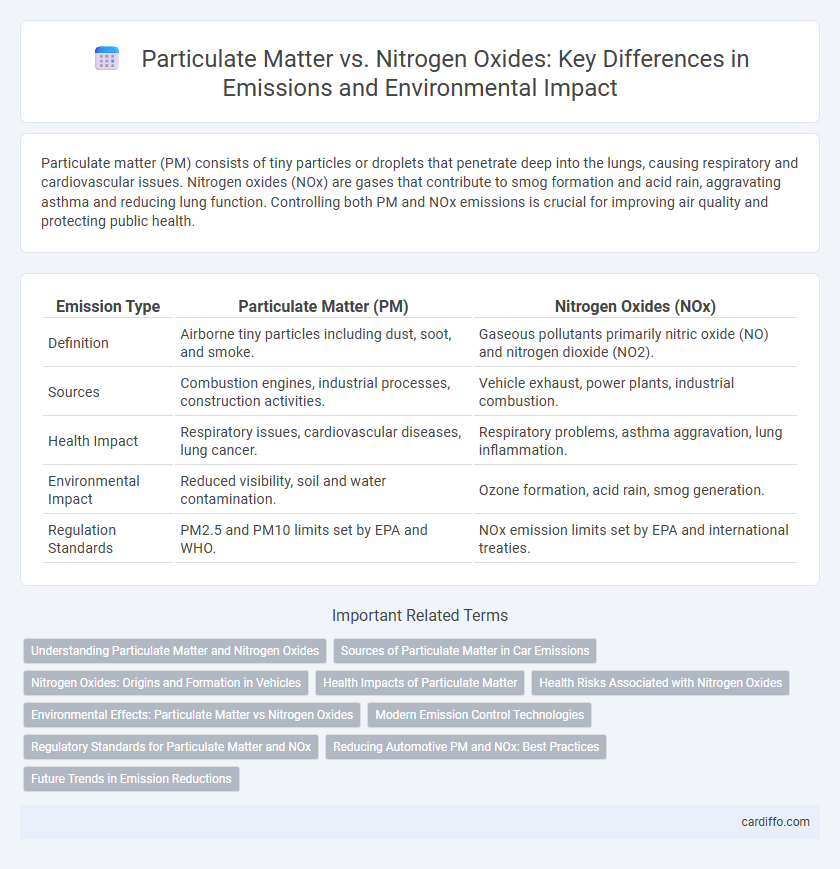Particulate matter (PM) consists of tiny particles or droplets that penetrate deep into the lungs, causing respiratory and cardiovascular issues. Nitrogen oxides (NOx) are gases that contribute to smog formation and acid rain, aggravating asthma and reducing lung function. Controlling both PM and NOx emissions is crucial for improving air quality and protecting public health.
Table of Comparison
| Emission Type | Particulate Matter (PM) | Nitrogen Oxides (NOx) |
|---|---|---|
| Definition | Airborne tiny particles including dust, soot, and smoke. | Gaseous pollutants primarily nitric oxide (NO) and nitrogen dioxide (NO2). |
| Sources | Combustion engines, industrial processes, construction activities. | Vehicle exhaust, power plants, industrial combustion. |
| Health Impact | Respiratory issues, cardiovascular diseases, lung cancer. | Respiratory problems, asthma aggravation, lung inflammation. |
| Environmental Impact | Reduced visibility, soil and water contamination. | Ozone formation, acid rain, smog generation. |
| Regulation Standards | PM2.5 and PM10 limits set by EPA and WHO. | NOx emission limits set by EPA and international treaties. |
Understanding Particulate Matter and Nitrogen Oxides
Particulate Matter (PM) consists of tiny solid or liquid particles suspended in the air, originating from sources such as vehicle exhaust, industrial emissions, and construction activities, posing severe health risks including respiratory and cardiovascular diseases. Nitrogen Oxides (NOx), primarily nitrogen dioxide (NO2) and nitric oxide (NO), are gases produced during combustion processes in vehicles and power plants, contributing to air pollution and forming ground-level ozone. Understanding the chemical composition, sources, and environmental impact of PM and NOx is crucial for developing effective emission control strategies and improving air quality.
Sources of Particulate Matter in Car Emissions
Sources of particulate matter in car emissions primarily include fuel combustion, tire and brake wear, and road dust resuspension. Diesel engines emit higher amounts of fine particulate matter (PM2.5) compared to gasoline engines due to incomplete fuel combustion. Additionally, abrasion from tires and brakes contributes significant non-exhaust particulate emissions affecting urban air quality.
Nitrogen Oxides: Origins and Formation in Vehicles
Nitrogen oxides (NOx) primarily originate from high-temperature combustion processes in vehicle engines, where nitrogen in the air reacts with oxygen under intense heat. Internal combustion engines, especially diesel and gasoline engines, produce NOx emissions due to incomplete combustion and rapid oxidation of nitrogen. Controlling NOx formation involves optimizing combustion temperature, using exhaust gas recirculation (EGR), and employing catalytic converters to reduce these harmful pollutants.
Health Impacts of Particulate Matter
Particulate Matter (PM), especially fine particles like PM2.5, poses severe health risks by penetrating deep into the respiratory system, causing cardiovascular and respiratory diseases. Unlike Nitrogen Oxides (NOx) which primarily irritate the respiratory tract, PM contributes to chronic conditions such as asthma, bronchitis, and increased mortality rates from heart attacks and strokes. Exposure to PM is linked to inflammation, reduced lung function, and heightened vulnerability to infections, making it a critical air pollutant for public health management.
Health Risks Associated with Nitrogen Oxides
Nitrogen oxides (NOx) significantly contribute to respiratory issues, including asthma exacerbation and reduced lung function, due to their capacity to irritate the respiratory system. Prolonged exposure to NOx increases the risk of chronic bronchitis and may impair immune response, making individuals more susceptible to respiratory infections. Unlike particulate matter, NOx also plays a crucial role in the formation of ground-level ozone, which further aggravates cardiovascular and pulmonary diseases.
Environmental Effects: Particulate Matter vs Nitrogen Oxides
Particulate matter (PM) causes respiratory and cardiovascular problems by penetrating deep into the lungs and bloodstream, significantly worsening air quality. Nitrogen oxides (NOx) contribute to ground-level ozone formation and acid rain, leading to ecosystem damage and reduced agricultural productivity. Both pollutants exacerbate climate change, with PM affecting atmospheric visibility and NOx acting as precursors to secondary pollutants harmful to human health and the environment.
Modern Emission Control Technologies
Modern emission control technologies utilize advanced particulate filters and selective catalytic reduction (SCR) systems to significantly reduce the release of particulate matter (PM) and nitrogen oxides (NOx) from combustion engines. Diesel particulate filters (DPFs) trap and oxidize PM, preventing harmful soot particles from entering the atmosphere. SCR systems convert NOx emissions into nitrogen and water using a urea-based additive, effectively lowering smog-forming pollutants and meeting stringent environmental regulations.
Regulatory Standards for Particulate Matter and NOx
Regulatory standards for particulate matter (PM) and nitrogen oxides (NOx) vary significantly due to their distinct health and environmental impacts. The U.S. Environmental Protection Agency (EPA) enforces National Ambient Air Quality Standards (NAAQS) limiting PM2.5 to 12 ug/m3 annually and NOx emissions through stringent vehicle and industrial source controls. European Union (EU) directives similarly impose strict limits, with PM10 concentration caps of 40 ug/m3 annually and NOx emission ceilings from power plants and diesel engines to mitigate air pollution-related health risks.
Reducing Automotive PM and NOx: Best Practices
Reducing automotive particulate matter (PM) and nitrogen oxides (NOx) emissions involves optimizing engine combustion technologies, such as implementing selective catalytic reduction (SCR) systems and diesel particulate filters (DPF). Advanced fuel injection techniques and the use of low-sulfur fuels significantly contribute to lowering PM and NOx levels. Regular maintenance and adopting hybrid or electric vehicle technologies further enhance emission reductions in automotive applications.
Future Trends in Emission Reductions
Particulate Matter (PM) emissions are expected to decline significantly through advanced filtration technologies and stricter regulatory standards targeting diesel and industrial sources. Nitrogen Oxides (NOx) reductions will increasingly rely on innovative catalytic converters, selective catalytic reduction (SCR) systems, and the transition to electric and hydrogen-powered vehicles. Emerging policies emphasize integrated approaches combining real-time monitoring, emission trading schemes, and enhanced renewable energy adoption to drive sustainable air quality improvements.
Particulate Matter vs Nitrogen Oxides Infographic

 cardiffo.com
cardiffo.com